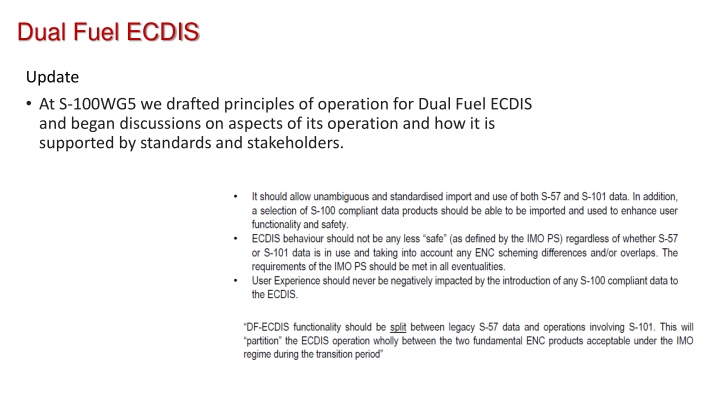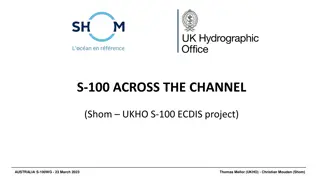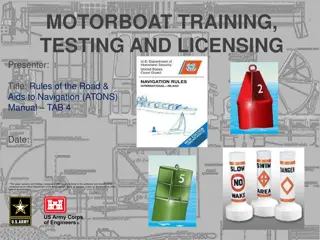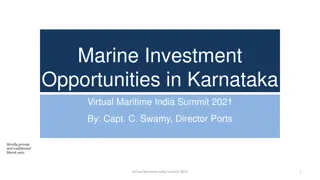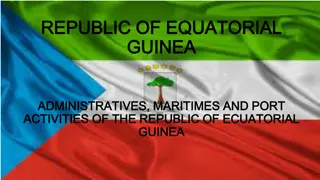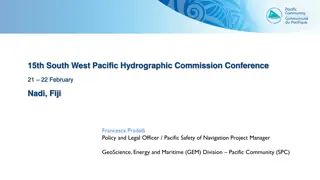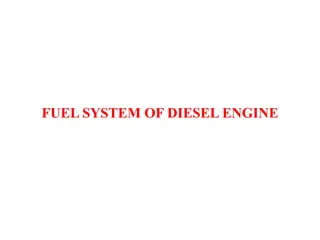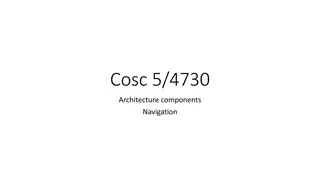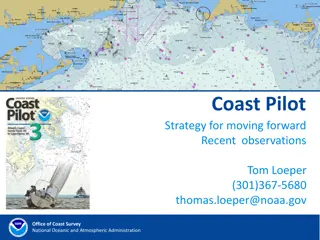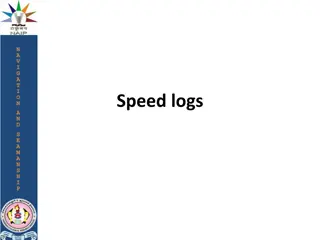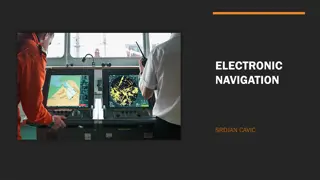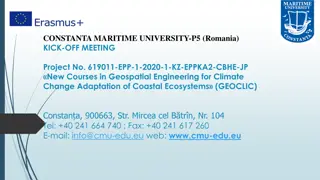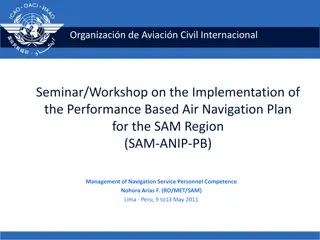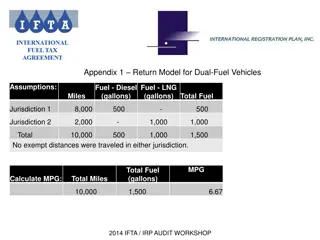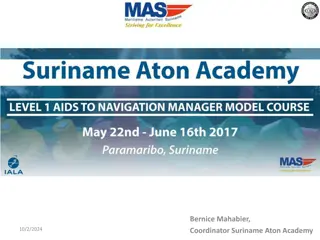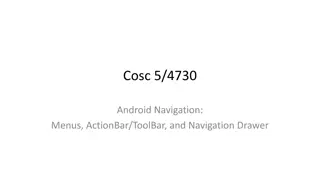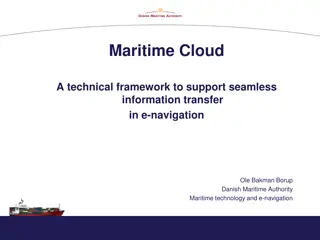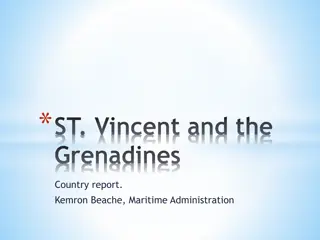Evolution and Implementation of Dual Fuel ECDIS in Maritime Navigation
Delve into the advancements in Dual Fuel ECDIS technology, exploring its principles, operational aspects, and stakeholder collaborations. Learn about the governance framework, content suggestions, and the integration of S-100 standards in ECDIS systems. Discover how Dual Fuel ECDIS bridges the gap between existing systems and future developments.
Download Presentation

Please find below an Image/Link to download the presentation.
The content on the website is provided AS IS for your information and personal use only. It may not be sold, licensed, or shared on other websites without obtaining consent from the author.If you encounter any issues during the download, it is possible that the publisher has removed the file from their server.
You are allowed to download the files provided on this website for personal or commercial use, subject to the condition that they are used lawfully. All files are the property of their respective owners.
The content on the website is provided AS IS for your information and personal use only. It may not be sold, licensed, or shared on other websites without obtaining consent from the author.
E N D
Presentation Transcript
Dual Fuel ECDIS Update At S-100WG5 we drafted principles of operation for Dual Fuel ECDIS and began discussions on aspects of its operation and how it is supported by standards and stakeholders.
What we said at HSSC Initial workshops have not identified any major issues with the rollout plan. There will certainly be challenges though. It is clear that defining the operation of Dual-Fuel ECDIS will require considerable effort from stakeholders across the ECDIS ecosystem and coordination between standards, regulatory and production efforts. S-100WG and ENCWG has commenced these activities and efforts in industry are also under way. Efforts will focus on Better definition of identical presentation regime - Portrayal Sub-WG Seamless Operation of DF-ECDIS (S-100WG and others) ENC Data Production - ENC Conversion sub-WG (and others) HSSC agreed on the Dual-Fuel Concept principles (Essential Principles of Operation) provided in Doc. HSSC12- 05.1F and tasked S-100WG/S-101PT to liaise with Stakeholders (OEM, etc.) to prepare a governance document that formalizes the guiding principles of DF-Concept for incorporation into the S100 Implementation Roadmap
Dual Fuel ECDIS Definition A Governance Document The aim of writing a governance document is to use the principles defined to capture clearly and simply: S-100 ECDIS How Dual Fuel ECDIS bridges the gap from now From HSSC. S-100WG has discussed the concept of dual-fuel ECDIS (DF-ECDIS) Papers at S-100WG5 proposed its operation, data handling and user experience can be made consistent and logical in accordance with the current, relevant standards The task at hand is to define better identical presentation regime and seamless operation in concrete terms There is a simple explanation of how DF-ECDIS works which can be written. From that: Promote the benefits of S-100 on the bridge Define each stakeholder group and the impact on them. Better define what changes are needed for non-IHO documents and processes
Content and Structure Suggestions S-100 ECDIS The expansion of ECDIS to include S-100 implementation S-100 contains fundamental re-statements of how information is managed Portrayal and Feature Catalogues Feature Models (S-101) Alarms and Indications, Context Parameters Data Loading Data Protection Added benefits Additional Information (S-100 product specifications) and its integration (Interoperability) Update (Catalogues) and Customisation (new product specifications, updated interoperability) Dual Fuel ECDIS The ability of an ECDIS to manage both S-57 and S-100 data simultaneously How data, portrayal and functionality can co-exist
Introduction and Background History of ECDIS and ENC development ECDIS stakeholders and their relationships. Top level definition of the S-100 ECDIS How S-100 differs from S-57 throughout the data path. What is ENC and SENC - Data suitable for primary navigation Extra Layers, what obscures and what doesn t (e.g Water Levels) Arbitrary Data Content Interoperability ECDIS Operations Ingest / Loading Portrayal, data loading Co-Display and behaviour of S-57/S-101 Summary What is S-100 ECDIS The Dual Fuel ECDIS concept IHO Transition period S-57 to S-100 Data Producers The transition concept Supporting transition through co-production Coverage and Scheming Support for ECDIS Operations Type approval testing Distribution IHO data protection scheme Loading, Ingest, management Data Loading - portrayal Display and co-Display Interoperability Operations. Standards (IHO, IMO) IMO/IEC and IHO standards framework How the S-100 framework functions to support navigation (+changes) Data Production Support ENC is the bare minimum considerations with multiple product specifications Other products and their benefits What should I produce? The IMO concept of the S-100 ECDIS IMO concepts (minimum test requirements) Display Alarms and Indications Other operations The path to S-100 only Transition to S-101/S-57 Co-production Adoption: initial conversion vs ongoing production Co-production guidance, coverage, scheming, consistency, validation Draft content Governance document.
S-100TSM is asked to: Note the contents of the paper provided Approve the creation of an overall Governance document in line with the definitions within the paper and the structure proposed
What does an ECDIS actually do? From IMO: Chart Loading and Unloading Update, manual and automated Display Feature Interrogation Alerts and Indications Areas where special conditions exist Safety Contour Generation. Route Planning and Monitoring "Other" functions - those stipulated by the PS. NEW PATHS, NEW APPROACHES
Principles of Operation - Agreed Fundamentals: SOLAS places an obligation on member states to produce and promulgate ENC data to support mandatory carriage of ECDIS. Currently that mandate is fulfilled by the production of S-57. The addition of S-100 to the IMO PS will allow S-100 data to also satisfy the carriage requirement. States will provide data which is safe using the relevant IHO standards (currently S-57) Principles: The principles of a dual fuel ECDIS should be: It should allow unambiguous and defined import and use of both S-57 and S-101 data. In addition, a selection of S-100 data products should be able to be imported and used to enhance user functionality and safety. ECDIS behaviour should not be any less safe (as defined by the IMO PS) whether S-57 or S-101 data is in use. The requirements of the IMO PS should be met in all eventualities. User Experience should not be negatively impacted by the introduction of any S-100 data to the ECDIS. NEW PATHS, NEW APPROACHES
The Transition period During the transition period: Data producers will produce data in both S-57 and S-101 forms: S-57 for (legacy) ECDIS which are unable to process S- 101 S-101 for (new) S-100 enabled ECDIS S-57 in areas where data has not been upgraded to S- 101 for BOTH S-100 and S-57 enabled ECDIS The 2024(neg) date for production of S-101 is the start of (partial) S-101 production by member states (and the operation of infrastructure supporting delivery, testing and support) Because data producers will need time to migrate entire production holdings to S-101 during the transition period, Dual Fuel ECDIS should accept both S-57 and S-101. NEW PATHS, NEW APPROACHES
Chart Loading and update DF-ECDIS suggests a side by side approach to loading/update: The ECDIS loads only S-57 or S-101 for any given area depending on availability, partitioning the SENC into discrete, mutually exclusive areas Updates always apply to data already in SENC. S-57/S-101 can overlap but not at same scale (or usage band). Coverage must be unambiguous Authoritative remains largest scale (CSCL or max display scale) S-101 Partition of SENC seems to be a reliable option Partition of portrayal Partition of functionality S-57 Don t convert data in the ECDIS. Don t convert portrayal either. NEW PATHS, NEW APPROACHES
Coverage During the transition period: Producers must ensure coverage in BOTH S-57 and S-101 for S-100 enabled ECDIS The ECDIS should not have to load both S-57 and S-101 in the same area at the same scale If the ECDIS is presented with two charts which overlap at the same scale in the same area then it should load, in preference, the S-101 data even if that excludes the import of a neighbouring S-57 cell. NEW PATHS, NEW APPROACHES
